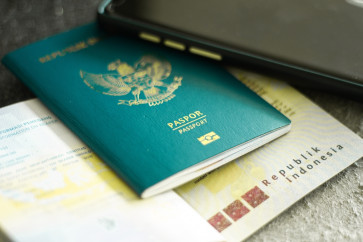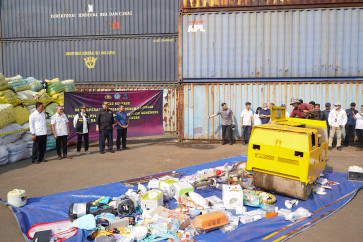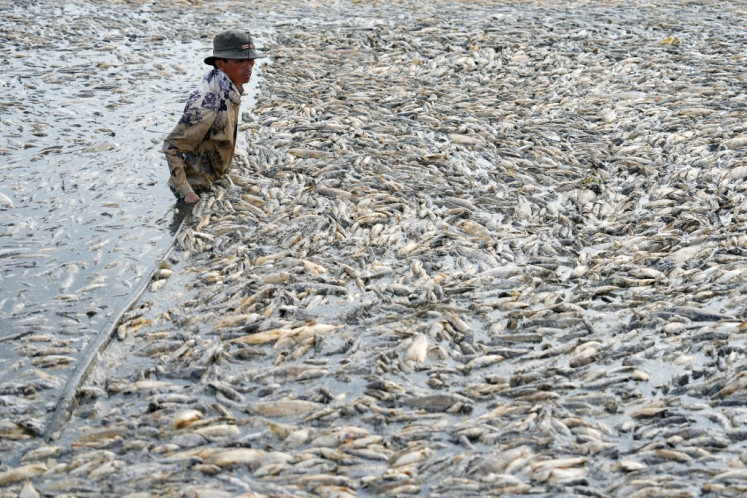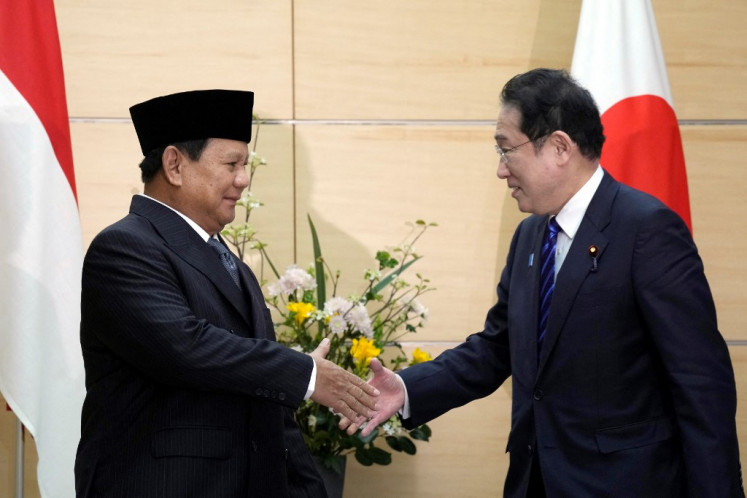Cooking controversy with palm oil
In May 2005, newly elected President Susilo Bambang Yudhoyono announced plans for the Kalimantan Border Oil Palm Mega Project
Change Size

I
span class="inline inline-left">In May 2005, newly elected President Susilo Bambang Yudhoyono announced plans for the Kalimantan Border Oil Palm Mega Project.
This is a 5-10-kilometer belt of oil palm plantations along the Indonesia-Malaysia border. The mega project planned to convert 1.8 million hectares including parts of three national parks. In 2006 the governments of Brunei, Indonesia and Malaysia jointly launched the Heart of Borneo conservation project that World Wildlife Fund (WWF), a major international environment NGO, initiated.
These two megaprojects exemplify the classic clash between development and conservation, between economic gain and environmental protection.
Oetami Dewi details this dichotomy in The Palm Oil Controversy in Southeast Asia, a Transnational Perspective. Her account is one striking example of what the palm oil business can stir.
Oetami's chapter, Reconciling Development, Conservation, and Social Justice in West Kalimantan is one of 12 highly informative essays in this 2013 ISEAS publication.
Drawn from her 2007 doctoral dissertation on farmer resistance to oil palm plantations in West Kalimantan, Oetami studies the human impact on the ground of this lucrative estate crop.
She argues the present mode of palm oil expansion based on large corporate plantations, imported labor and the takeover of customary land not only threatens forests but also leads to a structural poverty trap that can endure over generations.
Oetami offers a means to reconcile development and conservation by taking an oil palm scheme in Bengkulu province in Sumatra as an example.
The project in Sibak village, south Muko-Muko, provides for the local populace's economic and social development. A key to its success is the local community has control over the land. (pg 174-175)
On the palm oil controversy, the book's central theme, co-editor Oliver Pye cites three strands in his introduction.
First, oil palm is a monoculture that accelerates biodiversity loss from orangutans to birds and butterflies.
Second, linked to the European Union's use of biofuel for the transport sector, environmental NGOs like Greenpeace (and WALHI in Indonesia) see biofuel from palm oil as a 'fake solution' to climate change. This is because peatland converted to oil palm estates release immense amounts of carbon. Deforested and drained peatland is a major source of carbon dioxide emissions.
Third, the oil palm business has social implications: land conflicts, labor conditions and human rights abuses. (pg 2-3)
Teoh Cheng Hai in his chapter on Malaysian corporations tells of the establishment in April 2004 of the Roundtable on Sustainble Palm Oil (RSPO) to address the numerous issues linked to the controversy. RSPO is a multi-stakeholder platform of the key players in the supply chain to promote use of sustainable palm oil.
Teoh traces Malaysia's plantation industry in the colonial era. Sime Darby, founded by William Middleton Sime and Henry Darby in 1910, was one pioneer. It started with tea, coffee, rubber and in the 1960s developed oil palm. Major plantation firms are now transnational. Sime Darby is Malaysia's largest plantation company with oil palm estates in Malaysia and Indonesia.
Teoh, RSPO's first secretary general, argues that for long term sustainability oil palm firms must engage civil society stakeholders. Companies should not focus only on traditional stakeholders: customers, investors, suppliers and employees. Palm oil producers must also engage with environmental NGOs and social pressure groups that have influenced the palm oil supply chain of retailers and consumers.
Teoh notes Sime Darby's collaboration with social NGO Tenaganita on consulting the 300 plus women who work on its plantations. Many firms, however, often see NGOs as adversaries bent on bad press rather than partners in sustainable development.
The palm oil business is huge and transnational. It has upstream investments of over US$100 million in 200,000 hectares or more tracts. It has downstream enterprises in the multiple, flexible uses of palm oil: food, biofuel, commercial products like cosmetics. It provides global solutions to food and energy security.
However, it also throws in the wrench on ecosystem conservation and climate solution strategies. Further, forceful land taking, often by intimidation, has torn the social, economic and cultural fabric of forest communities.
The essays in the book are a tour d'horizon on the palm oil debate. Norman Jihan details the environmental consequences and the negative social impacts of the oil palm business in Indonesia.
He identifies the players in the business with the state-owned PTPNs having the largest total plantation area of over 700,000 hectares. The largest foreign-operated area is 573,000 hectares run by Wilmar of Singapore. In 2007 Wilmar had a market capitalization of $12 billion. Jihan examines state policies and insists the government must adopt human rights approaches to palm oil industry developments (pg 73).
Other chapters are on the rise of independent smallholders in Riau province; the European Union's Renewable Energy Directive (RED) that mandates use of biofuels; a model to analyze capital and product flows between oil palm plantation companies in Southeast Asia and relevant decision makers; the free, prior and informed consent (FPIC) principle; campaigning in Europe and Asia; migrant workers in Sabah; flexible migrant labor; and palm oil promotion in the Philippines.
The essays were papers presented at a March 2009 workshop in Singapore co-organized by the Institute of Oriental and Asian Studies in Bonn and the Institute of Southeast Asian Studies (ISEAS) in Singapore. All the presenters are academics, consultants or researchers in nongovernment organizations.
The viewpoint of one key stakeholder, however, is missing: the oil palm industry.
The book falls short of becoming a grand tour d'horizon. Although industry people were at the workshop, representatives of the Malaysian Palm Oil Association (MPOA) and the Indonesian Oil Palm Growers Association (GAPKI) could have responded to their critics and account on how they are engaging in consumer-accepted sustainable oil palm development.
The book should have come out one year after the workshop at the latest. Information is dated. Nonetheless, the book is an exceptional, analytical, well-written read.
So what is the status of the 1.8 million hectare Kalimantan Border Oil Palm Mega Project? It is still in the pipeline though greatly modified to 10 percent of the initial plan.
The Estate Crops Directorate General at the Agriculture Ministry did a study and found only 180,000 hectares of the land area is feasible for sustainable development. It held a workshop earlier this year and stated the border project, what is left of it, can start 2014 under the direction of the Office of the Coordinating Minister for Economic Affairs.
The Palm Oil Controversy in Southeast Asia A Transnational Perspective
Editors: Oliver Pye and
Jayati Bhattacharya
ISEAS, Singapore, 2013
283 pages









